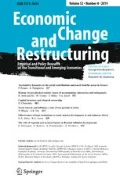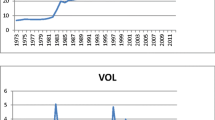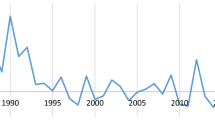Abstract
The impact of exchange rate volatility on the trade flows has been intensively studied by researchers after the adoption of flexible exchange rate system. Different studies have used data from different countries at different aggregation level. In this paper we consider the experiences of 57 Pakistan’s exporting to and 52 importing industries from the US over the period 1980–2014. We find that almost 50 % of the industries are affected by exchange rate volatility in the short-run. However, short-run effects last into the long run only in 26 exporting industries and 18 importing industries. Due to such disaggregation we find that all four large exporting and importing industries are affected positively in the long run. The list includes industries coded 656 (made up articles with 32.45 % of exports share), 841 (clothing with 50.7 % exports share), 263 (cotton with 8.64 % import share) and 282 (iron and steel scrap with 2.10 % imports share).

Similar content being viewed by others
Notes
See Sauer and Bohara (2001, p. 133). Note that LDCs stands for Less Developed Countries.
Note that due to different sample size, the level of exchange rate volatility was found to be I(1) by Doganlar (2002) who was then able to apply Engle–Granger method which requires all variables in a given model to be I(1). The same method was used by Saqib and Sana (2012) with the same outcome that aggregate exports of Pakistan are adversely affected by exchange rate volatility.
While most studies have concentrated on Pakistan’s exports, Alam and Ahmad (2010) considered Pakistan’s imports. After using cointegration analysis they did not find any significant impact of exchange rate volatility on Pakistan’s total imports.
Hassan (2013) is another study that considered response of total imports and total exports of Pakistan to volatility in exchange rate of major partners such as the US, UK and UAE. Once the export and import demand models were estimated, volatility of rupee–dollar had no significant impact but the other two exchange rate volatility measure had significantly positive impact.
For other applications of this method see For some other applications of this approach see Halicioglu (2007, 2013), Narayan et al. (2007), Tang (2007), Mohammadi et al. (2008), Wong and Tang (2008), De Vita and Kyaw (2008), Payne (2008), Dell’Anno and Halicioglu (2010), Chen and Chen (2012), Shahbaz et al. (2012), Wong (2013), Bahmani-Oskooee and Zhang (2014), Hajilee and Al-Nasser (2014), and Tayebi and Yazdani (2014).
The remaining industries that react adversely to rupee depreciation are 612, 651, 652, 656, 841, 891, 897 and 899.
For a graphical presentation of the CUSUM and CUSUMSQ tests see Bahmani-Oskooee et al. (2005).
These findings are similar to those of Bahmani-Oskooee and Wang (2007) who considered the case of US–China commodity trade, Bahmani-Oskooee and Hegerty (2009) who did similar analysis for the case of US–Mexico, Bahmani-Oskooee et al. (2015) who did the same for US–Egypt commodity trade and Bahmani-Oskooee and Durmaz (2016) for the case of US–Turkey except that all large industries in this paper are affected positively by exchange rate uncertainty.
References
Alam S, Ahmad QM (2010) Exchange rate volatility and Pakistan’s import demand: an application of autoregressive distributed lag model. Int Res J Finance Econ 48:7–22
Alam S, Ahmad QM (2011) Exchange rate volatility and Pakistan’s bilateral imports from major sources: an application of ARDL approach. Int J Econ Finance 3:245–254
Aqeel A, Nishat M (2006) The effect of exchange rate volatility on Pakistan’s exports. Pak Econ Soc Rev 44:81–92
Arize A, Malindertos J, Kasibhatla KM (2003) Does exchange-rate volatility depress export flows: the case of LDCs. Int Adv Econ Res 9:7–20
Bahmani-Oskooee M (1986) Determinants of international trade flows: case of developing countries. J Dev Econ 20:107–123
Bahmani-Oskooee M (1996) Exchange rate uncertainty and trade flows of LDC’s evidence from Johansen’s cointegration analysis. J Econ Dev 21(1):23–35
Bahmani-Oskooee M, Ardalani Z (2006) Exchange rate sensitivity of U.S. trade flows: evidence from industry data. South Econ J 72:542–559
Bahmani-Oskooee M, Durmaz N (2016) Exchange rate volatility and commodity trade between the U.S. and Turkey. Econ Change Restruct 49:1–21
Bahmani-Oskooee M, Hegerty SW (2007) Exchange rate volatility and trade flows: a review article. J Econ Stud 34:211–255
Bahmani-Oskooee M, Hegerty SW (2009) The effects of exchange-rate volatility on commodity trade between the United States and Mexico. South Econ J 75:1019–1044
Bahmani-Oskooee M, Ltaifa N (1992) Effects of exchange rate risk on exports: crosscountry analysis. World Dev 20:1173–1181
Bahmani-Oskooee M, Payesteh S (1993) Does exchange rate volatility deter trade volume of LDCs? J Econ Dev 18:189–205
Bahmani-Oskooee M, Tanku A (2008) The black market exchange rate vs. the official rate in testing PPP: which rate fosters the adjustment process? Econ Lett 99(1):40–43
Bahmani-Oskooee M, Wang Y (2007) Impact of exchange rate volatility on commodity trade between U.S. and China. Econ Issues 12:31–54
Bahmani-Oskooee M, Zhang R (2014) Is there J-Curve Effect in the commodity trade between Korea and rest of the world. Econ Change Restruct 47:227–250
Bahmani-Oskooee M, Economidou C, Goswami GG (2005) How sensitive are Britain’s inpayments and outpayments to the value of the British pound. J Econ Stud 32:455–467
Bahmani-Oskooee M, Hegerty SW, Hosny A (2015) The effects of exchange rate volatility on industry trade between the US and Egypt. Econ Change Restruct 48:93–117
Banerjee A, Dolado J, Mestre R (1998) Error-correction mechanism tests in a single equation framework. J Time Ser Anal 19:267–285
Chen S-W, Chen T-C (2012) Untangling the non-linear causal nexus between exchange rates and stock prices: new evidence from the OECD countries. J Econ Stud 39:231–259
De Vita G, Kyaw KS (2008) Determinants of capital flows to developing countries: a structural VAR analysis. J Econ Stud 35(3/4):304–322
Dell’Anno R, Halicioglu F (2010) An ARDL model of recorded and unrecorded economies in Turkey. J Econ Stud 37:627–646
Doganlar M (2002) Estimating the impact of exchange rate volatility on exports: evidence from Asian countries. Appl Econ Lett 9:859–863
Engle RF, Granger CWJ (1987) Cointegration and error correction: representation. Estim Test Econom 55:251–276
Hajilee M, Al-Nasser OM (2014) Exchange rate volatility and stock market development in emerging economies. J Post Keynes Econ 37:163–180
Halicioglu F (2007) The J-Curve dynamics of Turkish bilateral trade: a cointegration approach. J Econ Stud 34:103–119
Halicioglu F (2013) Dynamics of obesity in Finland. J Econ Stud 40:644–657
Hassan M (2013) Volatility of exchange rate effecting trade growth-a case of Pakistan with US, UK and UAE. Eur Sci J 9:277–288
Khan AJ, Azim P, Syed HS (2014) The impact of exchange rate volatility on trade: a panel study on Pakistan’s trading partners. Lahore J Econ 19:31–66
Kumar R, Dhawan R (1991) Exchange rate volatility and Pakistan’s exports to the developed world, 1974–85. World Dev 19:1225–1240
Mohammadi H, Cak M, Cak D (2008) Wagner’s hypothesis: new evidence from Turkey using the bounds testing approach. J Econ Stud 35:94–106
Mustafa K, Nishat M (2004) Volatility of exchange rate and export growth in Pakistan: the structure and interdependence in regional markets. Pak Dev Rev 43:813–828
Narayan PK (2005) The saving and investment nexus for China: evidence from cointegration test. Appl Econ 37(17):1979–1990
Narayan PK, Narayan S, Prasad BC, Prasad A (2007) Export-led growth hypothesis: evidence from Papua New Guinea and Fiji. J Econ Stud 34:341–351
Payne JE (2008) Inflation and inflation uncertainty: evidence from the Caribbean region. J Econ Stud 35:501–511
Pesaran MH, Shin Y, Smith R (2001) Bounds testing approaches to the analysis of level relationships. J Appl Econom 16:289–326
Saqib N, Sana I (2012) Exchange rate volatility and its effect on Pakistan’s export volume. Adv Manag Appl Econ 2:109–124
Sauer C, Bohara KA (2001) Exchange rate volatility and exports: regional differences between developing and industrialized countries. Rev Int Econ 9:133–152
Shahbaz M, Islam F, Aamir N (2012) Is devaluation contractionary? empirical evidence for Pakistan. Econ Change Restruct 45:299–316
Tang TC (2007) Money demand function for Southeast Asian countries: an empirical view from expenditure components. J Econ Stud 34:476–496
Tayebi SK, Yazdani M (2014) Financial crisis, oil shock and trade in Asia. J Econ Stud 41:601–614
Tsen Wong H (2013) Real exchange rate misalignment and economic growth in Malaysia. J Econ Stud 40:298–313
Wong KN, Tang TC (2008) The effects of exchange rate variablity on Malaysia’s disaggregated electrical exports. J Econ Stud 35:154–169
Acknowledgments
Valuable comments of an anonymous referee and those of the editor are greatly appreciated.
Author information
Authors and Affiliations
Corresponding author
Appendix: data and sources
Appendix: data and sources
Annual data over the period of 1980–2014 are used to carry out the estimation. They come from the following two sources.
-
(a)
The World Bank WITS system (World integrated trade solutions).
-
(b)
International financial statistics (IMF data).
1.1 Variables
- X i :
-
Pakistan’s export volume of industry i to the US. Nominal figures come from source a. In the absence of annual price level for each industry, we follow Bahmani-Oskooee and Ardalani (2006) and deflate each industry trade value by the Pakistan’s export unit value. The data of exports unit value come from source b
- M i :
-
Pakistan’s import volume of industry i from the US. Nominal import data for each industry come from source a. In the absence of annual import price level for each industry, again, we follow Bahmani-Oskooee and Ardalani (2006) and deflate each industry import value by the Pakistan’s import unit value index. Pakistan’s import unit value index comes from source b
- Y US :
-
The US real GDP, source b
- Y PAK :
-
Pakistan’s real GDP, source b
- REX :
-
The real bilateral exchange rate between Pakistani rupee and the US dollar. It is defined as (CPIUS × NEX)/CPIPAK, where NEX is the nominal bilateral exchange rate defined as number of rupees per dollar, CPIpak is the price level in Pakistan and CPIUS, the price level in the US. Data on all three variables come from source b
- V :
-
Volatility of the real bilateral exchange rate, REX. Following Bahmani-Oskooee and Hegerty (2009), V is calculated as standard deviation of the 12 monthly real exchange rate within that each year. Monthly CPI data for both countries and the nominal exchange rate data come from source b
Rights and permissions
About this article
Cite this article
Bahmani-Oskooee, M., Iqbal, J. & Khan, S.U. Impact of exchange rate volatility on the commodity trade between Pakistan and the US. Econ Change Restruct 50, 161–187 (2017). https://doi.org/10.1007/s10644-016-9187-9
Received:
Accepted:
Published:
Issue Date:
DOI: https://doi.org/10.1007/s10644-016-9187-9




